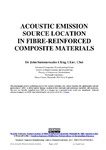Acoustic Emission Source Location in Fibre-Reinforced Composite Materials
| dc.contributor.author | Summerscales, John | |
| dc.date.accessioned | 2014-01-16T17:06:05Z | |
| dc.date.available | 2014-01-16T17:06:05Z | |
| dc.date.issued | 2013-08-31 | |
| dc.identifier.isbn | 978-1-870918-04-6 | |
| dc.identifier.uri | http://hdl.handle.net/10026.1/2866 | |
| dc.description | This monograph reviews calibration sources for acoustic emission (AE), source location (SL) philosophies and the application of AESL to defect and/or damage location in both isotropic and anisotropic materials and structures. The text was initially compiled circa 1993 as a chapter for a potential book which was abandoned. | |
| dc.description.abstract |
The acoustic emission (AE) from materials prior to and during damage is useful as a warning of impending failure. Deformation of the material generates short impulsive stress waves which can be detected at the surface by suitable instrumentation. The literature on acoustic emission from fibre composites has been reviewed by Arrington [1]. Drouillard has compiled comprehensive bibliographies on acoustic emission [2, 3]. It is often necessary to know the location of the acoustic emission source, especially during proof testing. This can be accomplished in a manner similar to that used by seismologists to locate the epicentre of an earthquake. A number of transducers on the surface of the component are monitored for the relative arrival times of the wavefront propagating in the test sample. The use of acoustic emission for source location, both in theory and in practice, has been summarised in an excellent booklet by Rindorf [5]. Chretien [6] proposed that two criteria should be met for successful acoustic emission source location: that the source has a much smaller volume than the dimensions of the structure, and that the signal from the source is very rapid Based on such conditions, the continuous signals from plastic deformation are not suitable for flaw location, but the bursttype emissions from crack initiation and propagation do fulfil the criteria. | |
| dc.format.extent | 6 | |
| dc.format.medium | E-book | |
| dc.language.iso | en | |
| dc.publisher | Advanced Composites Manufacturing Centre | |
| dc.subject | Acoustic emission | |
| dc.subject | Composite materials | |
| dc.subject | Source location | |
| dc.title | Acoustic Emission Source Location in Fibre-Reinforced Composite Materials | |
| dc.type | book | |
| plymouth.author-url | http://www.plymouth.ac.uk/staff/jsummerscales | |
| plymouth.publisher-url | http://www.tech.plym.ac.uk/sme/acmc/ | |
| plymouth.organisational-group | /Plymouth | |
| plymouth.organisational-group | /Plymouth/Faculty of Science and Engineering | |
| plymouth.organisational-group | /Plymouth/REF 2021 Researchers by UoA | |
| plymouth.organisational-group | /Plymouth/REF 2021 Researchers by UoA/UoA12 Engineering | |
| plymouth.organisational-group | /Plymouth/Research Groups | |
| plymouth.organisational-group | /Plymouth/Research Groups/Marine Institute | |
| plymouth.organisational-group | /Plymouth/Users by role | |
| plymouth.organisational-group | /Plymouth/Users by role/Academics | |
| dc.publisher.place | Plymouth - England | |
| dc.rights.embargoperiod | Not known | |
| rioxxterms.licenseref.uri | http://www.rioxx.net/licenses/all-rights-reserved | |
| rioxxterms.type | Book |


